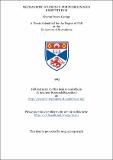Files in this item
Mechanistic studies in porphobilinogen biosynthesis
Item metadata
| dc.contributor.advisor | Butler, Anthony (Anthony R.) | |
| dc.contributor.author | George, Sharon Deena | |
| dc.coverage.spatial | 293 p. | en_US |
| dc.date.accessioned | 2018-07-16T14:02:21Z | |
| dc.date.available | 2018-07-16T14:02:21Z | |
| dc.date.issued | 1993 | |
| dc.identifier.uri | https://hdl.handle.net/10023/15431 | |
| dc.description.abstract | [4-¹⁵c]ALA.HC1 (50% enriched) and [¹⁵N]ALA.HC1 (50% enriched) have been synthesised and utilised in mechanistic studies. The synthesis of the former was achieved via a modified literature procedure, employing [2-¹³C] glycine (99.8% enriched) as the starting material. The NMR spectral data of the labelled materials have been fully characterised. ¹³C NMR studies of [4-¹³C]ALA.HCl (50% enriched) have demonstrated the forms of ALA and its autocondensation products under physiological conditions, ¹⁷O and ¹H NMR studies have confirmed the existence of the alternative forms of ALA and its condensation products at neutral pH. The non-enzymatic cyclic dimerisation of ALA leads to the formation of 2,5-bis(2- carboxyethyl)pyrazine and under some circumstances, pseudo-PBG. The condensation products of ALA under a variety of conditions have been identified from their NMR spectra and mechanisms for their formation are proposed. The condensation of ALA and its 5-methyl analogue with a variety of carbonyl compounds have been investigated and the products (novel substituted pyrroles in some cases) characterised by their melting points, elementary analyses, mass spectra and NMR spectra. A hydrogen bonded enaminoketone in a chelated ring has been identified as the intermediate in the reaction between ALA and 1,l,l-trlfluoropentane-2,4-dione, by 1H and 15N NMR spectroscopy. 13C NMR kinetics of the reaction between ALA and pentane- 2,4-dione has revealed that the reaction proceeds via an enaminoketone intermediate. The nature of the intermediate species in the above reaction was confirmed by 15N NMR spectroscopy. On the basis of the kinetic evidence obtained for the reaction between ALA and 1,1, l-trifluoropentane-2,4-dione, a mechanism has been proposed for the Knorr and Fischer-Fink P3nrrole syntheses. Studies with the bovine liver enzyme, ALA dehydratase, has revealed that it is very specific in the reaction that it catalyses: the Knorr-type dimerisation of two molecules of ALA to form PBG. The substrate analogues, levulinic acid and the methyl ester of ALA were found to be a non-competitive inhibitor and a very poor substrate of the enzyme respectively. The substrate analogues, N,N-dimethyl- ALA and 5-methyl-ALA do not bind to the enzyme and therefore do not affect the rate of production of PBG. A mechanism has been postulated for PBG biosynthesis, similar to the one proposed for the Knorr pyrrole synthesis. Stopped-flow kinetics of the reaction between p-nitrophenyl- diazonium tetrafluoroborate and bilirubin ditaurate disodium salt has revealed that diazonium ions are solely responsible for the cleavage of the central methylene bridge of the bilirubin conjugate molecule. On the basis of the above evidence, a mechanism has been proposed for the diazo coupling reaction. | en_US |
| dc.language.iso | en | en_US |
| dc.publisher | University of St Andrews | |
| dc.subject.lcc | QD431.2 P7G3 | |
| dc.title | Mechanistic studies in porphobilinogen biosynthesis | en_US |
| dc.type | Thesis | en_US |
| dc.contributor.sponsor | Rollo Trust | en_US |
| dc.type.qualificationlevel | Doctoral | en_US |
| dc.type.qualificationname | PhD Doctor of Philosophy | en_US |
| dc.publisher.institution | The University of St Andrews | en_US |
This item appears in the following Collection(s)
Items in the St Andrews Research Repository are protected by copyright, with all rights reserved, unless otherwise indicated.

